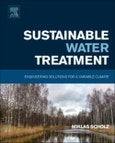Sustainable Water Treatment: Engineering Solutions for a Variable Climate covers sustainable water and environmental engineering aspects relevant for the drainage and treatment of storm water and wastewater. The book explains the fundamental science and engineering principles for the student and professional market. Standard and novel design recommendations for sustainable technologies, such as constructed wetlands, sustainable drainage systems and sustainable flood retention basins are provided to account for the interests of professional engineers and environmental scientists. The book presents the latest research findings in wastewater treatment and runoff control that are ideal for academics and senior consultants.
The book offers a challenging, diverse, holistic, multidisciplinary, experimental and modelling-orientated case study, covering topics such as natural wetlands, constructed treatment wetlands for pollution control, sustainable drainage systems managing diffuse pollution, specific applications, such as wetlands treating dye wastewater and ecological sanitation systems recycling treated waters for the irrigation of crops.
Please Note: This is an On Demand product, delivery may take up to 11 working days after payment has been received.
Table of Contents
1. Introduction to Sustainable Water Management 2. The Reconnaissance Drought Index 3. Temporal hydrologic anomalies coupled with drought impact for a river flow regime 4. Mineral and biological contamination of soil and Chillies irrigated with domestic wastewater treated by wetlands 5. Recycling of domestic wastewater treated by wetlands for irrigation of two generations of Chillies 6. Comparative study of domestic wastewater treatment by mature vertical-flow constructed wetlands and artificial ponds 7. Treatment of contaminated greywater using pelletised mine water sludge 8. Dye wastewater treatment by vertical-flow constructed wetlands 9. Shallow pond systems planted with duckweed treating azo dyes 10. Tree species for use in urban areas in temperate and oceanic climates 11. Feature selection methods for classifying sustainable flood retention basins 12. Predicting dam failure risk for sustainable flood retention basins
Authors
Miklas Scholz Division of Water Resources Engineering, Lund University, Lund, SwedenDirectorate of Civil Engineering, The University of Salford, Greater Manchester, UK
Department of Civil Engineering Science, University of Johannesburg, Johannesburg, South Africa.
Prof. Miklas Scholz, cand ing, BEng (equiv), PgC, MSc, PhD, CWEM, CEnv, CSci, CEng, FHEA, FIEMA, FCIWEM, FICE, Fellow of IWA holds the Chair in Civil Engineering at The University of Salford. He was previously working at The University of Edinburgh. He is the Head of the Civil Engineering Research Group in Salford.
He has shown individual excellence evidenced by contributions to world-leading publications, postgraduate supervision, and research impact. His main research areas in terms of publication output are treatment wetlands, integrated constructed wetlands, sustainable flood retention basins, permeable pavement systems, decision support systems, ponds, and capillary suction time. About 45% and 40% of his research is in water resources management and wastewater treatment, respectively. The remaining 15% is in capillary processes and water treatment.
He has published four books and more than 176 journal articles covering a wide area of topics. Between 2009 and 2015, he topped the publication list in terms of numbers for all members of staff at The University of Salford. Prof. Scholz's full journal article publications in recent years are as follows: 2009 (13), 2010 (19), 2011 (13), 2012 (21), 2013 (17), and 2014 (15). He has total citations of more than 2845 (above 2122 citations since 2010), resulting in an H-Index of 28 and an i10-Index of 64.
Prof. Scholz is Editor-in-Chief of 13 journals, including the Web of Science-listed journal Water (impact factor for 2014: 1.428). He has membership experience on over 35 influential editorial boards. His new guidelines on sustainable flood retention basins (SFRB) and integrated constructed wetlands (ICW) have led to the international uptake of both the novel SFRB and ICW concepts. This work has particularly benefited the British Isles, Central and Northern Europe, and has an excellent uptake potential for large regions in America, Asia and Africa.








